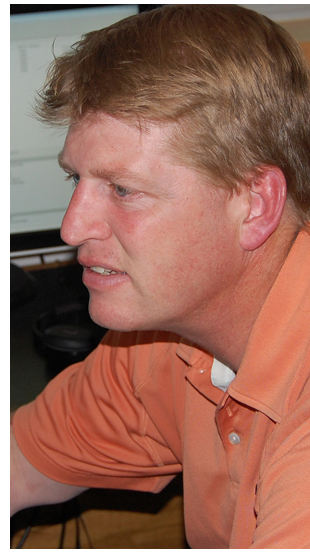
D6's McKee named "Next Generation" finalist
Mike McKee (pictured below), the District Materials Engineer in D6, known as ITD's three-dimensional (3D) and four-dimensional (4D) project modeling authority, was selected as a finalist in the Next Generation category of the recent Navigator Awards. McKee was selected as the Idaho Transportation Department Engineer of the Year in 2015. He started with ITD as an engineer-in-training in 2008.
McKee's nomination was based primarily on being named to head up the new, innovative Design/Build project development section in the D6 region. His project will replace up to 25 bridges in Districts 4, 5 and 6, starting in 2017. In this additional responsibility, he will direct a team in collecting and organizing engineering data on these bridges in preparation for determining project requirements and seeking best-value bids.
The Next Generation category of the awards lists the following description, "Some of the best ideas out there in state and local government are coming from individuals who are relatively new to the world of government. With more and more veteran public servants retiring, state and local governments have to attract and retain the next generation of public-sector leaders. Who are the unsung heroes who have taken a small idea and made it something much bigger and better? Who not only has the ideas, but the innovative mind to make it reality? Who has been able to collaborate within their government, outside their government and bring their managers and elected officials with them?"
Route Fifty Executive Editor Michael Grass said, "Going through Navigator Award nominations, we were impressed by submissions from the Idaho Transportation Department.
"For the Navigator Awards Next Generation category, we’re naming another finalist submission from the department: Mike McKee, a materials engineer in ITD’s District 6, which covers eastern Idaho."
Officials identified Mike's 3D construction modeling as an innovative practice for state transportation departments and contractors that improves overall construction quality while saving time and money. Meanwhile, the Federal Highway Administration has sponsored the "Every Day Counts" initiative across the nation, including 3D modeling for construction, which always starts with designers. McKee project modeling enables conflicts in the staging and relocating of utilities to be considered in the design phase rather than in the construction phase, which is too late for engineering efficiencies.
Mike was lead designer for a major, $9-million project in the region, on an overpass bridging a busy stretch of interstate. Using Microstation (computer-aided design [CAD] software), he modeled subsurface utilities in three dimensions, something District 6 had never done before. In the process, he identified conflicts in water, sewer, gas and fiber-optic utility lines ahead of construction. The 3D model could be rotated, with different layers of utility and roadway elements viewed as if constructed. Mike coordinated with city and county officials and utility companies to address needs and resolve conflicts early.
McKee, as lead designer on a number of projects, has saved the department significant money, and designed projects that came in ahead of time and under budget. In reviewing the hydraulic report for a rural culvert-replacement project, for instance, his recommendation saved the department $800,000.
Published 11-25-16